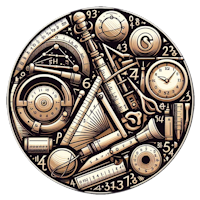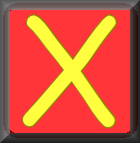
 |
VolumeUse formulae to solve problems involving the volumes of cuboids, prisms and other common solids. |
This is level 5; find the volumes of composite solid objects. You can earn a trophy if you get at least 7 questions correct and you do this activity online.
InstructionsTry your best to answer the questions above. Type your answers into the boxes provided leaving no spaces. As you work through the exercise regularly click the "check" button. If you have any wrong answers, do your best to do corrections but if there is anything you don't understand, please ask your teacher for help. When you have got all of the questions correct you may want to print out this page and paste it into your exercise book. If you keep your work in an ePortfolio you could take a screen shot of your answers and paste that into your Maths file. |
||
|
|
||
|
|

|
More Activities: |
|
Mathematicians are not the people who find Maths easy; they are the people who enjoy how mystifying, puzzling and hard it is. Are you a mathematician? Comment recorded on the 9 October 'Starter of the Day' page by Mr Jones, Wales: "I think that having a starter of the day helps improve maths in general. My pupils say they love them!!!" Comment recorded on the 1 February 'Starter of the Day' page by M Chant, Chase Lane School Harwich: "My year five children look forward to their daily challenge and enjoy the problems as much as I do. A great resource - thanks a million." |
Whose Idea Was This?Did you enjoy doing this 'Volume' activity? Are you curious about who originally came up with this idea in Maths? Discover more about one of the mathematicians who is associated with this concept. 
|
|
AnswersThere are answers to this exercise but they are available in this space to teachers, tutors and parents who have logged in to their Transum subscription on this computer. A Transum subscription unlocks the answers to the online exercises, quizzes and puzzles. It also provides the teacher with access to quality external links on each of the Transum Topic pages and the facility to add to the collection themselves. Subscribers can manage class lists, lesson plans and assessment data in the Class Admin application and have access to reports of the Transum Trophies earned by class members. If you would like to enjoy ad-free access to the thousands of Transum resources, receive our monthly newsletter, unlock the printable worksheets and see our Maths Lesson Finishers then sign up for a subscription now: Subscribe |
||
Go MathsLearning and understanding Mathematics, at every level, requires learner engagement. Mathematics is not a spectator sport. Sometimes traditional teaching fails to actively involve students. One way to address the problem is through the use of interactive activities and this web site provides many of those. The Go Maths page is an alphabetical list of free activities designed for students in Secondary/High school. Maths MapAre you looking for something specific? An exercise to supplement the topic you are studying at school at the moment perhaps. Navigate using our Maths Map to find exercises, puzzles and Maths lesson starters grouped by topic. | ||
Teachers | ||
|
If you found this activity useful don't forget to record it in your scheme of work or learning management system. The short URL, ready to be copied and pasted, is as follows: |
Alternatively, if you use Google Classroom, all you have to do is click on the green icon below in order to add this activity to one of your classes. |
It may be worth remembering that if Transum.org should go offline for whatever reason, there is a mirror site at Transum.info that contains most of the resources that are available here on Transum.org. When planning to use technology in your lesson always have a plan B! |
|
|
||
© Transum Mathematics :: This activity can be found online at:
www.Transum.org/go/?Num=263
Close

Level 1 - A basic exercise to find the number of cubes required to make the cuboid shown in the diagram
Level 2 - Use the width times height times length formula to find the volume of cuboids
Level 3 - Find the volumes of a wide range of prisms (including cylinders)
Level 4 - Find the volumes of pyramids, cones, spheres and other common solid shapes
Level 5 - Find the volumes of composite solid objects
Level 6 - Find the volumes of solid objects where the units of the dimensions may differ
Surface Area - Exercises on finding the surface area of solids
Cylinders - Apply formulae for the volumes and surface areas of cylinders
Surface Area = Volume - Can you find the ten cuboids that have numerically equal volumes and surface areas? A challenge in using technology.
Exam Style Questions - A collection of problems in the style of GCSE or IB/A-level exam paper questions (worked solutions are available for Transum subscribers).
More on this topic including lesson Starters, visual aids, investigations and self-marking exercises.
Answers to this exercise are available lower down this page when you are logged in to your Transum account. If you don’t yet have a Transum subscription one can be very quickly set up if you are a teacher, tutor or parent.
See the National Curriculum page for links to related online activities and resources.
Cube: \(s^3\) where \(s\) is the length of one edge.
Cuboid: \(l\times w\times h\) where \(l\) is the length, \(w\) is the width and \(h\) is the height of the cuboid.
Cylinder: \(h \times \pi r^2\) where \(h\) is the height (or length) of the cylinder and \(r\) is the radius of the circular end.
Cone: \(h \times \frac13 \pi r^2\) where \(h\) is the height of the cone and \(r\) is the radius of the circular base.
Square based pyramid: \(h \times \frac13 s^2\) where \(h\) is the height of the pyramid and s is the length of a side of the square base.
Sphere: \(\frac43 \pi r^3\) where \(r\) is the radius of the sphere.
Prism: Area of the cross section multiplied by the length of the prism.
| Unit | Relationship |
|---|---|
| cubic metre (m3) | 1 m3 = 1000 L |
| litre (L) | |
| centilitre (cL) | 100 cL = 1 L |
| millilitre (mL) | 1000 mL = 1 L |
| cubic centimetre (cm3) | 1000 cm3 = 1 L |
Close

Don't wait until you have finished the exercise before you click on the 'Check' button. Click it often as you work through the questions to see if you are answering them correctly. You can double-click the 'Check' button to make it float at the bottom of your screen.
Answers to this exercise are available lower down this page when you are logged in to your Transum account. If you don’t yet have a Transum subscription one can be very quickly set up if you are a teacher, tutor or parent.
Close

Dan Walker, Twitter
Thursday, January 31, 2019